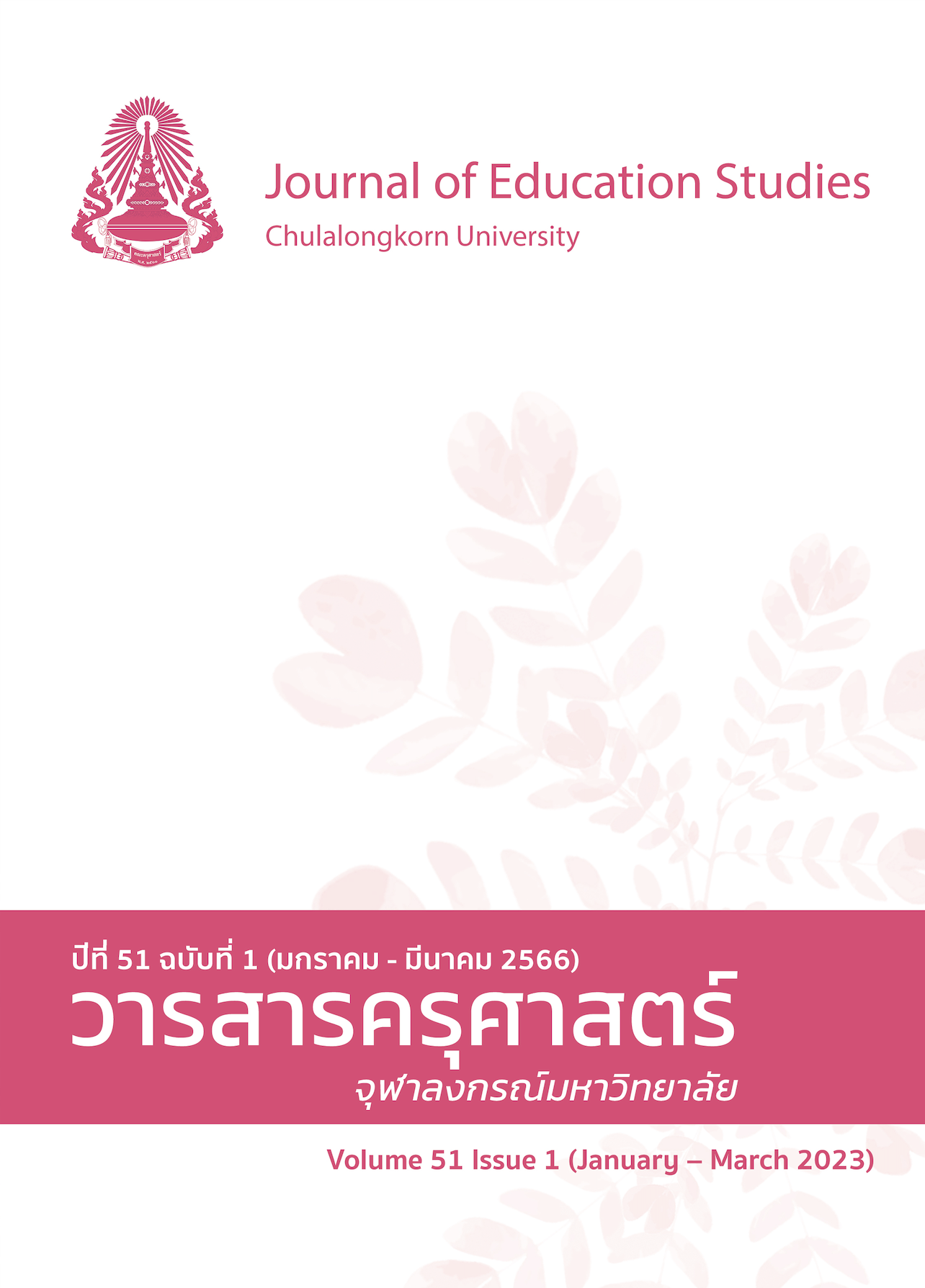Effects of Instruction Using STEM education Emphasized on Engineering Design Process on Collaborative Problem Solving Competencies of Lower Secondary School Students under the Office of the Higher Education Commission
DOI:
https://doi.org/10.14456/educu.2023.6Keywords:
collaborative problem solving competencies, STEM education, engineering design processAbstract
The purposes of this research were 1) to compare the collaborative problem-solving competencies of lower secondary school students before and after learning STEM lessons based on the engineering design process, and 2) to study the collaborative problem-solving competencies of lower secondary school after learning STEM lessons based on the engineering design process. The research sample included 42 lower secondary school students at a university demonstration school under the office of the Higher Education Commission, Ministry of Higher Education, Science, Research, and Innovation; the students were selected using purposive sampling. The instruments used in this research were STEM lessons based on engineering design process lesson plans. The research instrument used for data collection was a collaborative problem-solving competencies test. The data were analyzed by arithmetic mean, standard deviation, and t-test for dependent groups. The results of this research were that 1) the students’ collaborative problem-solving competencies and every sub-competency after learning with STEM lessons based on the engineering design process were higher than before learning at the .05 level of statistical significance and 2) the students’ collaborative problem-solving competencies mean scores were at a high level and were similar in all
sub-competencies.
References
ภาษาไทย
จักรกฤต ภุชงค์ประเวศ. (2564). ผลของการจัดการเรียนการสอนโครงงานวิทยาศาสตร์โดยใช้กระบวนการออกแบบเชิงวิศวกรรมที่มีต่อความสามารถในการแก้ปัญหาเชิงสร้างสรรค์และคุณภาพผลงานเชิงสร้างสรรค์ของนักเรียนระดับมัธยมศึกษาตอนต้น สังกัดคณะกรรมการการอุดมศึกษา. [วิทยานิพนธ์ปริญญามหาบัณฑิต ไม่ได้ตีพิมพ์]. จุฬาลงกรณ์มหาวิทยาลัย.
ปิยวรรณ มัธยมนันทน์. (2558). การพัฒนาทักษะการทำงานเป็นทีมของนักเรียนชั้นมัธยมศึกษาปีที่ 4 เรื่อง สภาพสมดุล โดยใช้ชุดกิจกรรมตามแนวทางการจัดการเรียนรู้สะเต็มศึกษา. [วิทยานิพนธ์ปริญญามหาบัณฑิต ไม่ได้ตีพิมพ์]. มหาวิทยาลัยอุบลราชธานี.
พรทิพย์ ศิริภัทราชัย. (2556). STEM Education กับการพัฒนาในศตวรรษที่ 21. วารสารวิชาการมหาวิทยาลัยศรีนครินทรวิโรฒ, 33(2), 50-55
สถาบันส่งเสริมการสอนวิทยาศาสตร์และเทคโนโลยี (สสวท.). (2563). PISA 2015 ผลการประเมินการแก้ปัญหาแบบร่วมมือ (Collaborative Problem Solving). กรุงเทพมหานคร: สถาบันส่งเสริมการสอนวิทยาศาสตร์และเทคโนโลยี.
สุวิมล ลาสังข์. (2562). ผลการจัดกิจกรรมสะเต็มศึกษาโดยใช้กระบวนการออกแบบเชิงวิศวกรรมที่มีต่อ ความสามารถในการแก้ปัญหาของนักเรียนระดับประถมศึกษา. [วิทยานิพนธ์ปริญญามหาบัณฑิต ไม่ได้ตีพิมพ์]. จุฬาลงกรณ์มหาวิทยาลัย.
สำนักงานเลขาธิการสภาการศึกษา กระทรวงศึกษาธิการ. (2562). แนวทางการพัฒนาสมรรถนะผู้เรียน ระดับ การศึกษาขั้นพื้นฐาน. (พิมพ์ครั้งที่ 1). 21 เซ็นจูรี่ จำกัด.
ภาษาอังกฤษ
Bybee, R. W. (2013). The case for STEM education: Challenges and opportunities. NSTA press.
Hesse, F., Care, E., Buder, J., Sassenberg, K., & Griffin, P. (2015). A framework for teachable collaborative problem solving skills. In Assessment and teaching of 21st century skills (pp. 37-56). Springer, Dordrecht.
Kuhn, D. (2015). Thinking together and alone. Educational researcher, 44(1), 46-53.
National Research Council. (2012). A framework for K-12 science education: Practices ,crosscutting concepts, and core ideas. The National Academies Press
OECD (2017). PISA 2015 Results (Volume V). Collaborative Problem Solving, OECD Publishing.
TeachEngineering STEM Curriculum for K-12 . (2018). Engineering Design process. TeachEndineering. https://www.teachengineering.org/k12engineering/why.
Downloads
Published
How to Cite
Issue
Section
License

This work is licensed under a Creative Commons Attribution-NonCommercial-NoDerivatives 4.0 International License.




